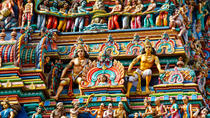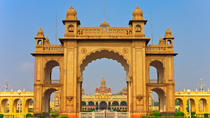Destination South India

South India lies in the peninsular Deccan Plateau and is bounded by the Arabian Sea in the west, the Indian Ocean in the south and the Bay of Bengal in the east. The geography of the region is diverse, encompassing two mountain ranges, the Western and Eastern Ghats, and a plateau heartland.
• Popular Desinations
» Destination Bangalore

Bangalore is the third largest city in India. Located in southern India on the Deccan Plateau, it is the capital of the southern Indian state of Karnataka. Bangalore is known as the Silicon Valley of India because of its role as the nation's leading information technology (IT) exporter. Located at a height of over 3,000 feet above sea level, Bangalore has a pleasant climate throughout the year …
» Destination Chennai

The area around Chennai had been part of successive South Indian kingdoms through centuries. The recorded history of the city began in the colonial times, specifically with the arrival of British East India Company and the establishment of Fort St. George in 1644. The British defended several attacks from the French colonial forces, and from the kingdom of Mysore, on Chennai's way to becoming a major naval port and presidency city by the late eighteenth century …
• Discover South India at-a-glance
» Andhra Pradesh

Andhra Pradesh has the second longest coastline of 972 km (604 mi) among all the states of India. Two major rivers, the Godavari and the Krishna, run across the state. The state comprises three regions: Telangana, Coastal Andhra and Rayalaseema. The primary official language of Andhra Pradesh is Telugu and the co-official language is Urdu. Other languages often spoken in the state include Hindi, Marathi, Tamil, Kannada and Oriya …
» Chennakesava Temple

The Chennakesava Temple located at Somanathapura is one of the finest examples of Hoysala architecture. The temple was built by Soma, a Dandanayaka (commander) in 1268 C.E. under Hoysala king Narasimha III, when the Hoysala Empire was the major power in South India. The ceiling of the mantapa (hall) is supported by lathe turned pillars, a standard feature in Hoysala constructions. Between pillars, the ceiling is domical and intricately decorated …
» Ethipothala Falls

Ethipothala Falls is a 70 foot high river cascade, situated on the Chandravanka river, a tributary of the River Krishna. The waterfall is a combination of three streams namely Chandravanka Vagu, Nakkala Vagu and Tummala Vagu. It is situated about 11 kilometres from Nagarjuna Sagar Dam. . A strategic view point was created by Andhra Pradesh Tourism Department from the adjacent hillock. There are Ranganatha and Dattatreya temples in the vicinity …
» Gol Gumbaz

Gol Gumbaz or Gol Gumbadh, meaning rose dome - a reference to the flower/rose/lotus petals that surround the dome at its base, making it appear as a budding rose - is the mausoleum of Mohammed Adil Shah, Sultan of Bijapur. The tomb, located in Bijapur, Karnataka in India, was completed in 1656 by the architect Yaqut of Dabul. Gol Gumbaz at Bijapur, has the second largest pre-modern dome in the world after the Byzantine Hagia Sophia …
» Jog Falls

Jog Falls is the second-highest plunge waterfall in India. Located near Sagara, Karnataka, these segmented falls are a major tourist attraction. They are also called Gersoppa Falls, Gersoppa Falls and Jogada Gundi. Sharavati, a river which rises at Ambutirtha, near Nonabur, in the Thirthahalli taluk and takes the northwesterly course by Fatte petta, receives the Haridravati on the right below Pattaguppe and the Yenne Hole on the left above Barangi …
» Karnataka

Karnataka's pre-history goes back to a paleolithic hand-axe culture evidenced by discoveries of, among other things, hand axes and cleavers in the region. Evidence of neolithic and megalithic cultures have also been found in the state. Gold discovered in Harappa was found to be imported from mines in Karnataka, prompting scholars to hypothesize about contacts between ancient Karnataka and the Indus Valley Civilization ca. 3000 BCE …
» Kanaka Durga Temple

Kanaka Durga Temple is a famous Hindu Temple of Goddess Kanaka Durga located in Vijayawada, Andhra Pradesh. The temple is located on the Indrakeeladri hill, on the banks of Krishna River. Kaalika puraana, Durgaa sapthashati and other vedic literature have mentioned about Goddess Kanaka Durga on the Indrakeelaadri and have described the deity as Swayambhu, (self-manifested) in Triteeya kalpa …
» Kerala

Kerala was a prominent spice exporter from 3000 BCE to 3rd century. The Chera Dynasty was the first powerful kingdom based in Kerala, though it frequently struggled against attacks from the neighbouring Cholas and Pandyas. During the Chera period Kerala remained an international spice trading center. Later, in the 15th century, the lucrative spice trade attracted Portuguese traders to Kerala, and eventually paved the way for the European colonisation of the whole of India …
» Marayur

Marayur or Marayoor is a place in Kerala state, South India. 42 kilometers north of Munnar through the Udumalppetta route, Marayur is the only place in Kerala that has natural sandalwood forests. Ancient dolmens and rock paintings in Marayur date back to the Stone Age. The most probable meaning of the place name is the Uru (Village) of Maravars; a tribe lived in this area during the turn of Christian Era, who used to attack travelers for looting, hiding in the forest …
» Meenakshi Amman Temple

Meenakshi Amman Temple is a historic Hindu temple located in the southern bank of river Vaigai in the temple city of Madurai, Tamil Nadu, India. It is dedicated to Parvati who is known as Meenakshi and her consort, Shiva, named here as Sundareswarar. The temple forms the heart and lifeline of the 2500 year old city of Madurai. The complex houses 14 gateway towers called gopurams, ranging from 45-50m in height, the tallest being the southern tower, 51.9 metres (170 ft) high …
» Mysore Palace

This city of palaces was once the capital of the great Mysore kingdom which ruled over a large part of South India for more than 500 years. This small and charming city still has a regal air, with its wide tree-lined avenues and many magnificent palaces and heritage buildings which are the vestiges of its royal past. Mysore gets its name from "Mahishuru," which means "abode of the Mahisha", the evil demon who was defeated by the goddess Chamundeshwari in a 10-day long battle …
» Ramappa Temple

Ramappa gudi, also known as the Ramalingeswara temple, is located 77 km from Warangal, the ancient capital of the Kakatiya dynasty, 157 km from Hyderabad in the state of Andhra Pradesh in southern India. It lies in a valley at Palampet village of Venkatapur Mandal, in erstwhile Mulug Taluq of Warangal district, a tiny village long past its days of glory in the 13th and 14th centuries. An inscription in the temple dates it to the year 1213 …
» Shore Temple

Shore Temple (built in 700-728 AD) is so named because it overlooks the shore of the Bay of Bengal. It is a structural temple, built with blocks of granite, dating from the 8th century AD. It was built on a promontory sticking out into the Bay of Bengal at Mahabalipuram, a village south of Chennai in the state of Tamil Nadu in India. At the time of its creation, the village was a busy port during the reign of Narasimhavarman II of the Pallava dynasty …
» Tamil Nadu

Tamil Nadu has a wide range of Biomes extending east from the South Western Ghats montane rain forests in the Western Ghats through the South Deccan Plateau dry deciduous forests and Deccan thorn scrub forests to tropical dry broadleaf forests and then to the beaches, estuaries, salt marshes, mangroves, and coral reefs of the Bay of Bengal. The state has a range of flora and fauna with many species and habitats. Biospheres protect larger areas of natural habitat …
» Telugu Cuisine

Telugu Cuisine is a cuisine of South India native to the Telugu people from the state of Andhra Pradesh, India. It is also the cuisine of the Telugu speaking population of Karnataka and Tamil Nadu, but with slight variations due to local influences. Generally known for its tangy, hot and spicy taste, the cooking is very diverse due to the vast spread of the people and varied topological regions. The state is the leading producer of red chili and rice in India …
» Tirumala Venkateswara Temple

Tirumala Venkateswara Temple is a Hindu temple in the hill town of Tirumala, near Tirupati in Chittoor district of Andhra Pradesh. The Tirumala Hill is 853m above sea level and is about 10.33 square miles (27 km2) in area. It comprises seven peaks, representing the seven heads of Adisesha, thus earning the name Seshachalam. The seven peaks are called Seshadri, Neeladri, Garudadri, Anjanadri, Vrushabhadri, Narayanadri and Venkatadri …






